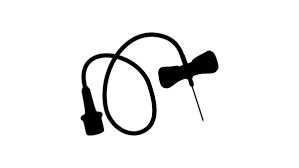When using a butterfly needle for venipuncture on dorsal hand veins, which of the following actions should the phlebotomist take?
Position the needle at a 45° angle to the skin.
Hold the needle by the wings of the butterfly.
Instruct the patient to hold the collection tubes.
Apply the tourniquet at the antecubital area.
The Correct Answer is B
Choice A Reason:
Positioning the needle at a 45° angle to the skin is not the recommended approach for venipuncture using a butterfly needle on dorsal hand veins. The correct angle for insertion is usually less than 45°, often around 15-30°, to ensure a shallow entry and reduce the risk of going through the vein.
Choice B Reason:
Holding the needle by the wings of the butterfly is the correct technique. This allows for better control and stability during insertion. The wings are designed to be held between the thumb and forefinger, providing an easy grip for the phlebotomist to maneuver the needle with precision.
Choice C Reason:
Instructing the patient to hold the collection tubes is not standard practice and could lead to pre-analytical errors. The phlebotomist should maintain control of the tubes to ensure proper blood flow and fill volume, as well as to prevent contamination or accidents.
Choice D Reason:
Applying the tourniquet at the antecubital area is not specific to the use of a butterfly needle for venipuncture on dorsal hand veins. While a tourniquet is used to engorge the veins and make them more prominent, its placement may vary depending on the selected puncture site and is not the action in question here.

Nursing Test Bank
Naxlex Comprehensive Predictor Exams
Related Questions
Correct Answer is A
Explanation
Choice A reason:
When encountering a patient who appears motionless and cyanotic, the first action should be to assess their level of consciousness. Asking loudly if they are okay can help determine if the patient is responsive or unresponsive. If there is no response, this indicates that the patient may be unconscious and requires further immediate assessment and potential intervention.
Choice B reason:
The head-tilt-chin-lift maneuver is used to open the airway of an unresponsive patient who is not suspected of having a spinal injury. However, this is not the first step. Before performing any maneuvers, it is essential to determine the patient's level of consciousness and whether they are breathing.
Choice C reason:
Administering rescue breaths is part of the process of cardiopulmonary resuscitation (CPR), which is only initiated after confirming that the patient is unresponsive and not breathing normally. This step comes after checking for responsiveness and breathing.
Choice D reason:
Looking, listening, and feeling for breathing movements is part of the assessment to determine if the patient is breathing normally. This is done after establishing unresponsiveness but before initiating CPR. It is a critical step, but it follows after confirming that the patient does not respond to verbal stimuli.
Correct Answer is B
Explanation
Choice A Reason:
Wrapping the site with a heel warmer for 30 minutes is a preparatory step before the heel stick procedure. It is used to increase blood flow to the area to make the collection easier. However, it is not the action to take after the blood has been collected. The heel warmer should be removed before performing the heel stick.
Choice B Reason:
Wiping away the first drop of blood is the correct procedure. The initial drop may be contaminated with tissue fluids or alcohol if the site was cleaned prior to the stick, which can affect the accuracy of the test results. Therefore, the first drop should be wiped away, and subsequent blood should be used for the PKU test.
Choice C Reason:
Keeping a pressure dressing on the site for the entire day is not necessary and is not part of the standard heel stick procedure. After the blood is collected, a small bandage is typically applied to stop any bleeding. The site should be monitored for a short time for any signs of continued bleeding or bruising, but a pressure dressing for the day is excessive.
Choice D Reason:
Targeting the central arch area of the foot for the heel stick is incorrect and can be harmful. The recommended area for a heel stick is the lateral portions of the heel to minimize discomfort and avoid injury to the bone or nerves. The central arch area should be avoided to prevent potential harm.
Whether you are a student looking to ace your exams or a practicing nurse seeking to enhance your expertise , our nursing education contents will empower you with the confidence and competence to make a difference in the lives of patients and become a respected leader in the healthcare field.
Visit Naxlex, invest in your future and unlock endless possibilities with our unparalleled nursing education contents today
Report Wrong Answer on the Current Question
Do you disagree with the answer? If yes, what is your expected answer? Explain.
Kindly be descriptive with the issue you are facing.
